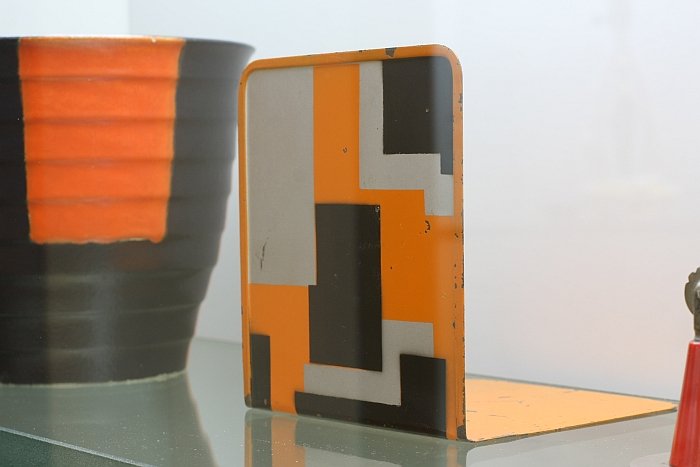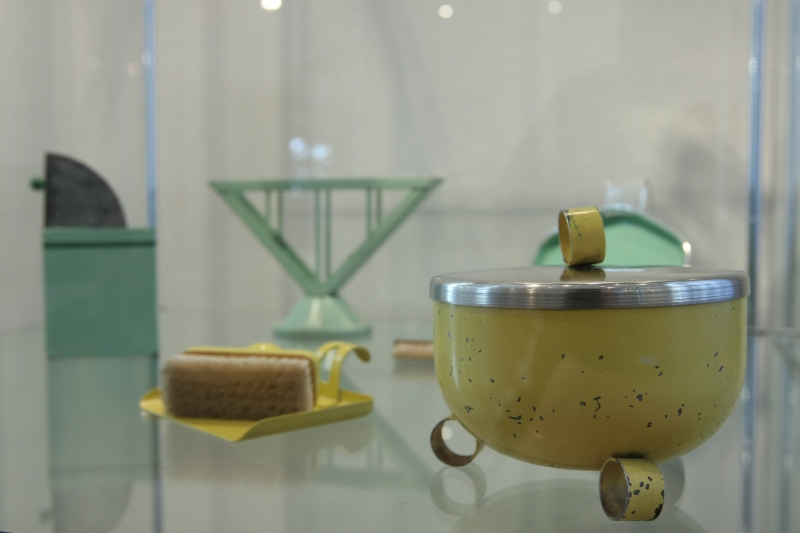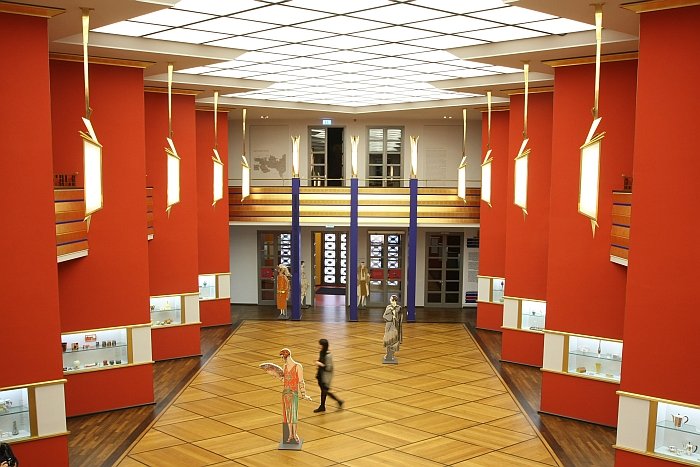The inclusion of a sheet steel bookend amongst our photos from the Grassi Museum for Applied Arts exhibition “Art Déco: Smart, Precious, Sensual” resulted in one or the other queried look in our direction, enquiries after our health and even questions as to if all our other photos were so unusable that, in our desperation, we had been reduced to using a shot of a piece of understatedly painted bent sheet steel.
No, no we replied, all was good. As were the rest of our photos.
That bookend however, produced as it was around 1930 by the Gotha based Ruppelwerk metal fabricators, is and was an excellent example of how the ideas of modernism washed away the aesthetic conventions and standards of Art Nouveau and Art Déco. And of how Bauhaus graduates played a central role in that process.

Established in 1870 by the brothers Emanuel and Abraham Ruppel, Ruppelwerk Gotha began life as an ironmongers business before quickly developing into a manufacturer of sheet steel objects, initially industrial goods, in particular for the then fledgling automotive industry but from 1897 also "Galanterie- und Luxuswaren" - modish and luxury goods - essentially household goods but those aimed at the burgeoning middle class of the late 19th/early 20th century rather than the simpler worker folk: napkin holders, ink wells, powder boxes and all manner of smoking tools and paraphernalia. In 1928 the Bauhaus graduate Wolfgang Tümpel was engaged very briefly by Ruppelwerk to design new objects for the Galanterie- und Luxuswaren range before in December 1929 Marianne Brandt arrived in Gotha and took on the responsibility of creating new objects and generally overhauling the existing collections.
Born in Chemnitz in 1893 Marianne Brandt née Lieb initially studied painting and sculpture at the Großherzoglich-Sächsischen Hochschule für Bildende Kunst in Weimar before in 1924 she enrolled in its successor institution, Bauhaus Weimar. Moving with Bauhaus to Dessau in 1926 Marianne Brandt began working in the institution's metal workshop in 1927 before being appointed assistant head of the metal workshop in 1928. Following her graduation in 1929 Marianne Brandt initially spent some five months working in Walter Gropius's atelier in Berlin before on December 10th 1929 she took up a position with Ruppelwerk GmbH in Gotha.
Which brings us to the bookend.
In 1935 Walter Gropius wrote to numerous Bauhäusler to ask what they had undertaken since leaving Bauhaus, with whom they had cooperated and in how far they had been able to put the Bauhaus ideals into practice.
In her answer Marianne Brandt is humble almost to the point of sounding embarrassed.
"It has not been easy for me to assemble a list. Hopefully one or the other item meets with your approval", she begins before later in context of her time with Ruppelwerk noting "I was generally assured I had managed to transform the rather convoluted and sad portfolio into something more contemporary"
Included with her letter was a series of images of Ruppelwerk products created before she arrived and ones created under her leadership, largely one suspects to allow Gropius to see what she had achieved.
Amongst the "before" products are two simple bent sheet steel bookends with the comment from Marianne Brandt: "form really good, but the decoration!"
The "after" photos combined with the post 1930 price lists nicely illustrate how Marianne Brandt altered the Ruppelwerk collection; in particular the images in price list Nr. 141 perfectly illustrate how Marianne Brandt advanced the Ruppelwerk bookend collection.
In her 1935 letter to Gropius Marianne Brandt wrote that "in place of the so-called luxury requirement and "novelty items" I took into full account the nature of the production to introduce things which for me represent a genuine need and which correspond to practical requirements. Rather than painted or stencil applied "decoration" I focussed on setting an accent through using different coloured parts (e.g. wooden balls and chrome plated metal), attached by screws or rivets."
And that is pretty much what was done. The illustrated bookends often being devoid of decoration, when then very minimal, graphic and structured, but more often than not the individuality of the pieces is accentuated through additions to or disruption of the quadratic form via indentations and curves. For us however the zenith of Marianne Brandt's evolution of the Ruppelwerk bookend can be seen in price list Nr. 134 from the second half of 1933 which features a bookend with page markers - a very reduced, unassuming bookend to which is attached three small nickel page markers. For where are you likely to need page markers if not while standing at a bookcase....

Which brings us back to the Grassi museum's bookend and the, perhaps, given what we've just written, somewhat surprising question, if it is from Marianne Brandt?
Marianne Brandt was employed at Ruppelwerk Gotha from 1929 until 1932, and so the the bookend in question was produced during her tenure; yet the nature of her time there is such that there is no way of knowing with 100% certainty which objects she developed - everything is simply listed as "Ruppelwerk".
The curators of Art Déco: Smart, Precious, Sensual haven't listed their Ruppelwerk bookend as being by Marianne Brandt. The curators of the 2009 exhibition "Modern, aber nicht modisch - Bauhauskünstler in Gotha" staged at the Stiftung Schloss Friedenstein Gotha listed an identical piece in green and grey as being by Marianne Brandt. We tend to side with Grassi, simply because of Marianne Brandt's stated desire to move away from "painted or stencil applied "decoration". The design is however quadratic and abstract enough, and represents enough of a move away from the "before" styles and of Marianne Brandt's use of colour, to make us genuinely query our own conclusion. And so.......
However the exact providence of that exact bookend is not the important issue. The bookend stands simply as representative of Marianne Brandt's time at Ruppelwerk and the works she realised; for despite the relatively short time Marianne Brandt spent in Gotha her time at Ruppelwerk is one of those excellent reminders that Bauhaus wasn't all about the "star" names and the celebrated Meisters, "normal" Bauhaus graduates worked with real companies, producing real products and instigating real change through the consistent and committed application of what they had learned in Weimar and Dessau.
And thus in a simple bent sheet steel bookend we have not only a lovely example of how the move from Art Nouveau through Art Déco to Modernism progressed but also how Marianne Brandt developed as a designer.
Thus quite aside from happily publishing one photo of one bookend we'd happily publish a series of photos of a series of bookends to illustrate that story in its full glory
Art Déco: Smart, Precious, Sensual runs at the Grassi Museum for Applied Arts, Johannisplatz 5-11, 04103 Leipzig until Sunday April 3rd. Full details can be found at www.grassimuseum.de
